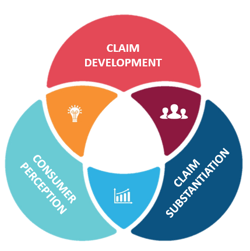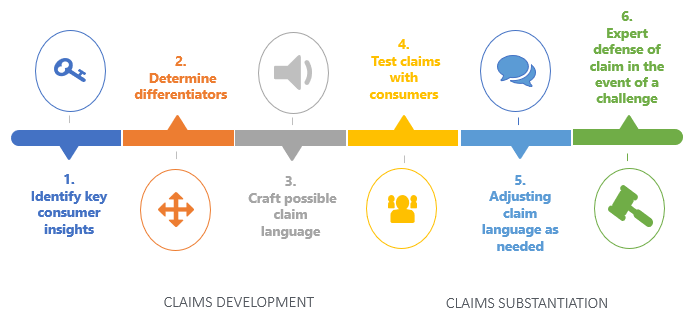Advertising Claims Process
Our approach to developing and rolling out a claim may include three steps:
- Claim Development
- Claim Substantiation
- Consumer Perception Testing

Below is an overview of the advertising claims process:

Claims Development Process
Claims development is the process of developing effective advertising and packaging claims that drive sales and strengthen brands. The claims development process is composed of fours steps:
- Identifying key insights
- Determining differentiators
- Crafting possible claim language
- Testing claims with consumers
1. Identify key consumer insights
Effective claims are insights-centric. The claims should be related to the key benefits that are important to consumers; benefits that can be traced back to an important customer want or need.
Identifying the features or benefits of a product or service that are most important to customer can sometimes be done through secondary research about the category, provided it’s sufficiently detailed. More often, primary qualitative research is the best approach.
Conducting primary qualitative research, such as Voice of the Customer (VOC) research, uncovers the most important unmet customer needs. Companies that develop new products based on an in-depth understanding of customer wants and needs have a great starting point for beginning to think about claims. The need the product was developed to address is often a good need around which to make a product claim because 1) it's consumer relevant and 2) it’s a key differentiator for the product.
2. Determine differentiators
In addition, any product or advertising claim developed should be differentiated. Differentiated claims are those that help a product stand out from the other products in the market. They often speak to key product benefits or features that are unique to the product. The best claims succeed in helping convince consumers that the offering is the one to purchase and at the same time, help build brand equity.
When conducting primary research, it’s helpful to understand which needs in the category are most important to customers. This can be done through a quantitative survey. Needs that are important but unsatisfied in the marketplace can be ripe areas for innovation. If you’re able to address these important unmet needs, consider developing a claim about these market differentiators.
3. Craft possible claim language
Begin by thinking broadly before narrowing down options to a few that are most realistic. When narrowing down the claims in the consideration set, critically evaluate each claim and make sure it is:
Believable: The claim should be true and consumers should trust that the claim is accurate. Even if substantiated, claims that consumers have difficulty believing are unlikely to be successful.
Clear: The consumer benefit of the claim should be unambiguous. The claim should be tested to make sure that it’s unlikely to be misinterpreted by consumers.
Consistent with the brand image: Both the message and tone of voice used in the claim should be consistent with the brand. Ensure that the tone of voice used is consistent with the brand personality or with the brand personality that’s being created if the brand has yet to be established.
In consumer’s language: The claim should use the words consumers would use and should avoid company jargon. Make a point of using words and phrases that consumers would use to describe your product to ensure that the claim resonates with your target customer.
Where to make the claim
When working to develop the claim, consider where the claim will be made.
Zero Moment of Truth
Claims made at the zero moment of truth are those that customers might encounter when researching a product or service. They include claims that may be made online, as well as in print, radio and television advertisements. Claims made at the zero moment of truth might focus on the product benefits and are often intended to help bring customers to the point of purchase.
First Moment of Truth
Claims made at the first moment of truth are those made at the point of purchase. They can appear on the product packing, shelf displays or as part of point of purchase materials, such as those on in-store display. These claims are viewed when customers are actively considering different options and are often focused on driving purchase. They may be preference claims or tout differentiated product benefits.
4. Test claim language with consumers
After developing possible claims for ads, package labels, and other marketing materials, it can be valuable to test the claim language with consumers to ensure consumers take away the message you intend and to ensure the claim resonates with consumers. Questions to answer during testing may include:
- What do consumers understand the claim to mean?
- Is the claim compelling?
- How does the claim stand out compared to competitor claims?
- Would consumers take the desired action as a result of seeing the claim?
Learn tips for developing effective product claims that strengthen a brand in our webinar-on-demand: Make a Statement: Developing effective claims that stand out. Watch Now.
Claims Substantiation Process
When it comes to advertising, claims must be supported by "competent and reliable scientific evidence."
To begin the process of substantiating a claim, it’s important to identify the claim language you wish to substantiate because this claim language will drive the method and type of data needed.
The claim substantiation process is composed of two steps:
- Design and conduct a study to test whether you have support for the claim (e.g., develop a sampling plan and identify the type of data required to test your claim)
- In the event of a challenge, prepare for an expert defense of the claim
1. Conduct study to test whether you have support for the claim
There are several critical steps in the research development process for claim substantiation. Critically, claim substantiation research is different from traditional market research, because it’s held to very exacting standards so it’s important that substantiation research be designed to survive the scrutiny of competitors and other regulatory boards. Knowledge and experience with the standards and guidelines for claims research (e.g., Standard Guide for Sensory Claim Substantiation by ASTM International) is critical at this stage. A survey expert should help with:
Identification of Respondent Population/Universe
The respondent population will depend on the type of claim you wish to make, but could be future purchasers, current product owners/users, the customers of a particular competitor, or a type of expert in the industry. The expert will help evaluate what type of population will be most relevant to substantiating a particular claim.
Development of Dependent Measures
Data collected from dependent measures often include consumers’ attitudes and behaviors such as:
- Opinions and beliefs
- Past experiences with the product or competitors’
- Likelihood of purchasing a product based on certain information
- Product preferences of their degree of liking for certain products
- Ratings of different products on sensory attributes like fragrance, taste, softness, etc.
Choosing the Appropriate Mode for Data Collection
The expert will suggest a data collection method appropriate for your study. Possible methods include:
Online Surveys: Collection of attitude and behavior over the Internet.
Some benefits include: speed at which data can be collected, cost, standardization/no interviewer influence, good geographic representation
Central Location Tests: Collection of data at a shopping mall or interviewing facility. Some benefits include: high degree of control over respondent behavior, easy to provide access to product
Home Use Test: Collection of data where respondents use a product in their homes. Some benefits include: data collected under naturalistic conditions, less interviewer influence, can accommodate longer test periods
2. Expert defense in the event of a challenge
It’s important to work with an experienced expert witness who can defend your study in the event of a challenge. An expert will help you work through issues around consumer perception such as whether or not you have considered all the likely take-away messages from the claim in the greater context of your advertising.
Learn the methodologies of competent and reliable scientific evidence for substantiating advertising claims in our webinar-on-demand: Make a Statement: Why claim substantiation matters.
Watch Now.
Consumer Perception Research
When planning claim substantiation research to evaluate support for a new advertising claim, it's important to look beyond "literal" claim substantiation and also consider the message that consumers will take away from the claim in the context of your advertising. Everything from word placement to imagery can affect what message(s) consumers take away from an advertisement. Select an expert who is experienced with the design and analysis of consumer perception studies. The expert can assess whether your advertisement, or a competitor's advertisement, communicates more than a claim intends.
Additional Resources
Blog Posts
- Advertising Claims: Your Brand's Elevator Pitch
- Frequently Asked Questions about Claims Development
- Strengthen Your Brand with Claims Research
- Advertising Claims: Claims Substantiation and Consumer Perception
- Advertising Claims: Claims Substantiation and Consumer Perception (Part 2)
- Data collection strategies for claim substantiation
- From Development to Defense: The Comprehensive Advertising Claims Process
Webinars On-Demand


